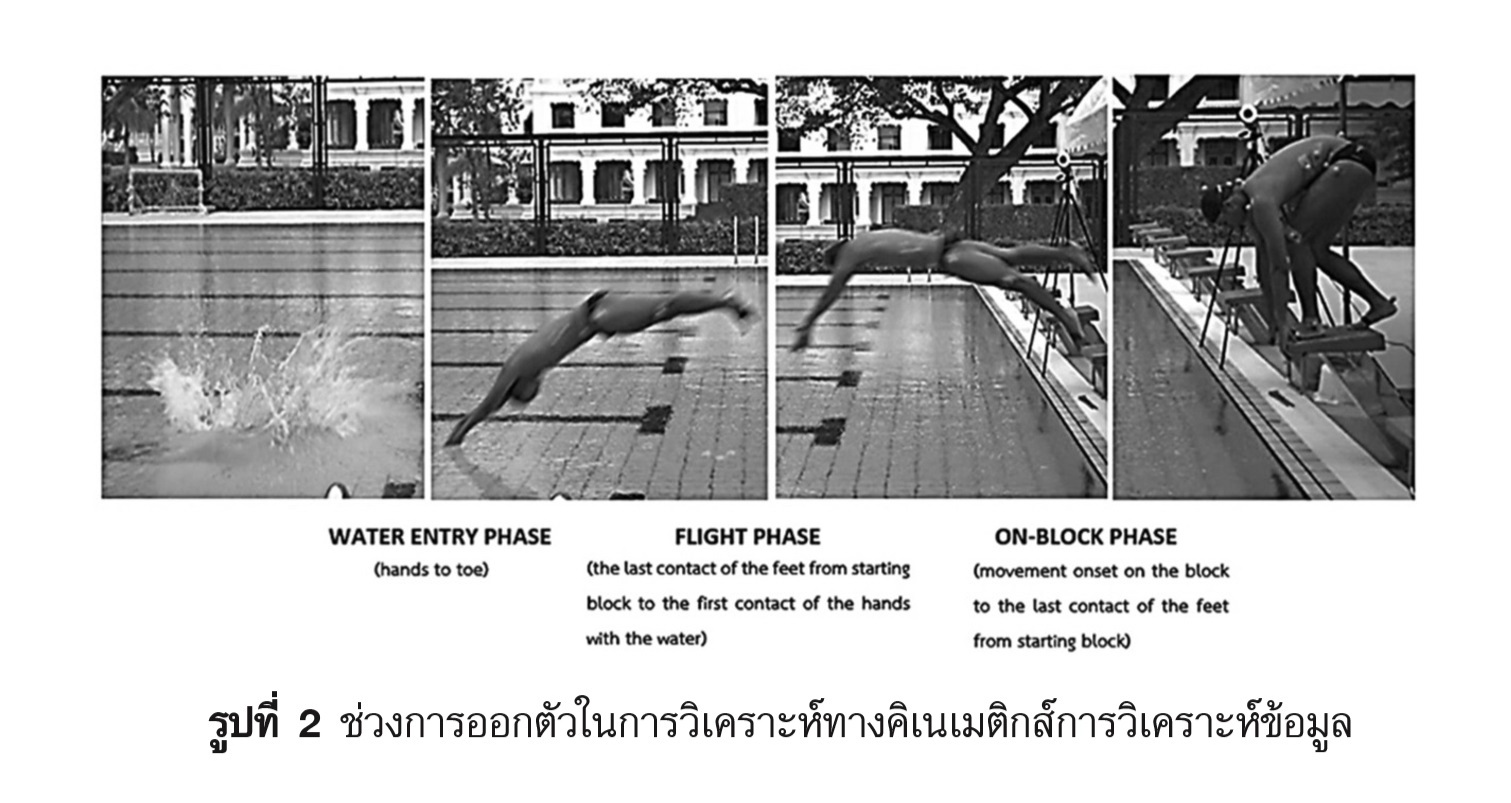KINEMATIC ANALYSIS OF A TRACK SWIMMING START IN MALE UNIVERSITY SWIMMERS
Main Article Content
Abstract
Purpose : The purpose of this research was to study and compare the kinematics data of track swimming start during short and long flight distance in male university swimmers.
Methods : Thirteen male swimmers from Chulalongkorn University were recruited for this study. Each swimmer performed a track swimming start with a maximum start speed ten times in which the shortest and the longest flight distance were chosen for analysis. 3-D kinematic was captured with four markers were placed on vertex of the skull, tip of left middle finger, tip of left iliac crest and head of left fifth metatarsal based on the Plug-In Gait Body Marker Placement. The paired t-test was used to compare differences in kinematics data of short and long flight distance. A level of significant was set at p-value ≤ 0.05.
Results : The results showed that the horizontal velocity at take-off, take-off angle, flight time, entry angles, and time to entry were differences (p<0.05) between the longest and shortest flight distance. When the flight distance increased, the flight time increased but time to entry decreased. On the other hand, the horizontal velocity to entry was not significant different between two flight distances.
Conclusion : A long-flight distance (about 2 times the height of athlete) is more effective in allowing swimmers to enter the water quickly compared to a short-flight distance.
Article Details
References
Alptekin, A. (2014). Body Composition and Kinematic Analysis of the Grab Start in Youth Swimmers Journal of Human Kinetics, 42, 15-26. doi:10.2478/hukin-2014-0057
Arellano, R., Cossor, J., Wilson, B., Cjatard, J., Riewald, S., & Mason, B. (2001). Modelling competitive swimming in different strokes and distances upon regression analysis: a study of the female participants of Sydney 2000 Olympic Games. Blackwell JR, Sanders RH XIXth International Symposium on Biomechanics in Sports. San Francisco; University of California, 53-56.
Blanksby, B., Nicholson, L., & Elliott, B. (2002). A biomechanical comparison of the grab, swing and track starts in swimming. Journal of Human Movement Studies, 39, 277-293.
Cossor, J., & Mason, B. (2001). Swim start performances at the Sydney 2000 Olympic Games. Paper presented at the XIXth International Symposium on Biomechanics in Sports, San Francisco.
Costill D.L. (1992). Handbook of sports medicine and science: swimming. Oxford, Blackwell Scientific.
Counsilman, J., Nomura, T., Endo, M., & Counsilman, B. (1988). A study of three types of grab start for competitive swimming. National Aquatics Journal, 4 (2), 2-6
Guimaraes, A., & Hay, J. (1985). A mechanical analysis of the grab starting technique in swimming. International Journal of Sport Biomechanics, 1, 25-35
Hay, J.C. (1986). Swimming Biomechanics: A brief review. Swimming Technique. Journal of Biomechanics, 23(3), 15-21.
Honda, K., Sinclair, P., Mason, B., & Pease, D. (2010). A biomechanical comparison of elite swimmers start performance using the traditional track start and the new kick start. Retrieved 18 February 2017 from https://www.coachesinfo.com/index.php?option=com_content&view=article&id=10308:a-biomechanical-comparisonof-eliteswimmers-start-performance-usingthe-traditional-track-start-and-the-newkick-start&catid=34:swimming-generalarticles&Itemid=334
Jorgic, B., Puletic, M., Stankovic, R., Okicic, T., Bubanj, S., & Bubanj, R. (2010). The kinematic analysis of the grab and track start in swimming. Journal of Physical Education and Sport, 8(10), 31-36
Kirner, K., Bock, M., & elch, J. (1989). A comparison of four different start combinations. Journal of Swimming Research, 5(2), 5-11
Kiuchi, H., Nakashima, M., Cheng, K., & Hubbard, M. (2010). Modeling fluid forces in the dive start of competitive swimming. Journal of Applied Biomechanics and Engineering, 5(4), 314-328.
Lee, C.Y., Huang, C.F., & Lee, C.W. (2012). Biomechanical analysis of the grab and track swimming starts. Paper presented at the 30th Annual Conference of Biomechanics in Sports Melbourne, Australia.
Lyttle, A., & Benjanuvatra, N. (2005). Start right? A biomechanical review of dive start performance. Retrieved from: https://coachesinfo.com/index.php?option=com_content&view=article&id=89:swimming-start-style&catid=g&Itemid=86
Maglischo, E. (2003). Swimming Fastest. Human Kinetics. Champaign, Illinois, U.S.A.
Murrell, D., & Dragunas, A. (2012). A comparison of two swimming start techniques from the Omega OSR11 Block. Western Undergraduate Research Journal: Health and Natural Sciences, 3. doi:10.5206/wurjhns.2012-13.1
Slawson, S., Conway, P., Justham, L., Le Sage, T., & West, A. (2010). Dynamic signature for tumble turn performance in swimming. Procedia Engineering, 2(2), 3391-3396.
Slawson, S., Conway, P., Cossor, J., Chakravorti, N., & West, A. (2013). The categorisation of swimming start performance with reference to force generation on the main block and footrest components of the Omega OSB11 start blocks. Journal of Sports Sciences, 31(5), 468-478.
Vantorre, J., Chollet, D., & Seifert, L. (2014). Biomechanical analysis of the swim start: A review Sports Science and Medicine, 13(2), 223-231.
Welcher, R. L., Hinrichs, R. N., & George, T. R. (2008). Front or rearweighted track start or grab start: which is the best for female swimmers? Sports Biomechanics, 7(1), 100-113.


